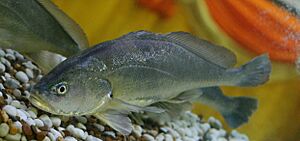Boesemania facts for kids
Quick facts for kids Boesemania |
|
|---|---|
 |
|
| Conservation status | |
| Scientific classification | |
| Synonyms | |
|
The Boeseman croaker (scientific name: Boesemania microlepis) is a special type of freshwater fish. It's the only species in its group, called Boesemania. This fish is also known as the smallscale croaker. You can find it living in rivers across southeast Asian countries.
Contents
About the Boeseman Croaker's Family Tree
The Boeseman croaker, or Boesemania microlepis, is part of a fish family called Sciaenidae. These fish are often called "croakers" because of the sounds they make!
The group Boesemania was first named in 1977 by a scientist named Ethelwynn Trewavas. She decided that the Johnius microlepis fish, which was described earlier in 1858 by Pieter Bleeker, was unique enough to have its own special group. So, Boesemania microlepis became the only member of the Boesemania group.
What Does the Boeseman Croaker Look Like?
The Boeseman croaker is a pretty big fish! It can grow up to about 100 centimeters (that's 1 meter or about 3 feet 3 inches) long. However, most of the time, they are around 20 centimeters (about 8 inches) long. The heaviest ones can weigh up to 18 kilograms (about 40 pounds).
Body Features
This fish has a thin part near its tail called the caudal peduncle. Its mouth is at the very front of its head and opens slightly upwards. The upper jaw reaches back to the eye.
Teeth and Fins
Boeseman croakers have both small and large teeth in their jaws. The large teeth are on the outside of the upper jaw and on the inside of the lower jaw. They do not have sharp, canine-like teeth.
Their dorsal fin (the one on their back) has 9 or 10 stiff spines. Behind these, it has one more spine and 27 to 34 soft rays. The anal fin (on their belly) has 2 spines and 7 soft rays. The second spine on this fin is very long. The tail fin is pointed.
Scales and Colors
The fish has smooth scales on its snout and cheeks. The rest of its body has rougher scales. A special line of scales, called the lateral line, runs all the way to the tip of its tail.
Boeseman croakers are grayish-brown on their sides and back. Their belly is lighter in color. They also have faint dark lines across their back. Their fins are yellow, with light dark spots on the dorsal and tail fins.
Swim Bladder
Inside their body, they have a special organ called a swim bladder. It helps them float. This swim bladder is shaped like a carrot. It has tube-like parts that stick out from it, both towards the front and the back.
Where Does the Boeseman Croaker Live?
You can find Boesemania microlepis in mainland Southeast Asia. This includes countries like Cambodia, Laos, Vietnam, and Thailand. They also live on the island of Sumatra in Indonesia.
They live in several large rivers. Some of these rivers are the Mekong, Chao Phraya River, Mae Klong, Nan River, Tha Chin River, and Bang Pakong River.
How Does the Boeseman Croaker Live?
Boeseman croakers seem to stay in one place. They prefer to live in large rivers where the water flows well.
Spawning and Sounds
During the driest part of the year, they lay their eggs (spawn) in deep pools of water. At this time, like other croaker fish, they can make very loud, continuous croaking sounds. It's how they communicate!
What Does the Boeseman Croaker Eat?
The Boeseman croaker mostly eats small fish. They also enjoy eating crustaceans, like shrimps.
Why Is the Boeseman Croaker Threatened?
People really like to eat Boeseman croakers. They are quite expensive in places like southern Laos, Thailand, and northeast Cambodia. Because so many people want to catch them for food, they are being caught too much. This "overfishing" is making them more and more threatened.


